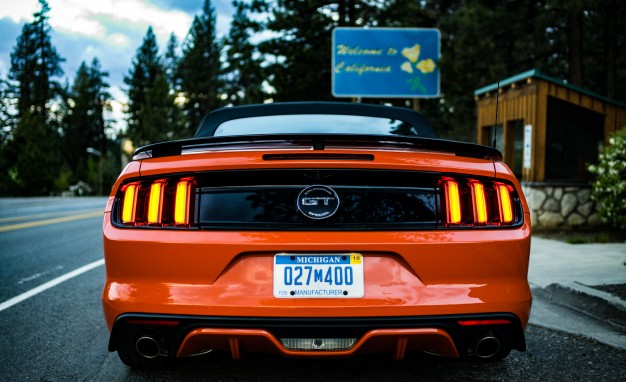
As far as the unwashed masses were concerned, the most interesting thing in the United States in 1849 was California gold. In 1959, it was the automobile. In 2016, it’s the internet. California gorged on all three, because California is a fundamentally progressive place. Not necessarily capital-P Progressive, though its lefty elements are often part of the state’s perception. And if the Mustang GT caved to progress by finally parting with its live rear axle, it is, in concept, very much a dinosaur of an automobile. Despite ABS, traction and stability control, and a modern infotainment system, the manual-transmission Mustang is about as analog-feeling as a mass-market automobile gets these days. It’s a car that plays well in California’s impossibly vast middle, a “middle” that somewhat confusingly, exists not only in the Tennesee-sized Central Valley, but also in the deserts, the more remote regions of the state’s coast, and sees itself littered throughout the mountains that ring the place.
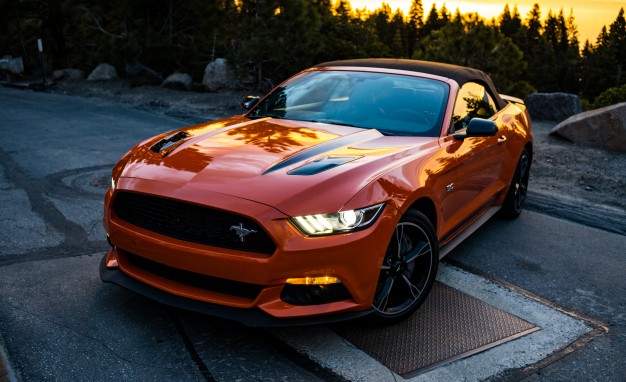
More than any other state in the Union, California exists as much in myth as reality. Grand statements tend to be thrown about, musing on either its perfection or its utter awfulness. The truth is that life in California is as varied as its geography. But in 1967, when California Ford dealers petitioned Dearborn for a Mustang variant of their very own, they certainly weren’t thinking about the rise of the United Farm Workers, the Free Speech Movement, or the nascent Black Panther Party. After all, the state had just elected a Hollywood actor as its governor the year before, Los Angeles was the undeniable capital of the global car scene, and West Coast psychedelia was leaving its indelible imprint on popular culture. So in early 1968, Ford launched the Mustang GT/CS—or California Special—which confusingly, was not necessarily a Mustang GT.
Developed by Carrol Shelby, the GT/CS package was purely about aesthetics. Unlike its Shelby-badged contemporaries, the fiberglass side scoops were blocked off, and the Thunderbird-style taillights didn’t blink sequentially. Though any available Mustang engine could be opted for, most cars were sold carrying a 289-cubic-inch V-8 topped with a pedestrian two-barrel carburetor. The 2016 GT/CS is a little bit different in concept. Although it wears fewer unique body parts than the ’68 car did, it is most assuredly a GT, featuring the excellent 435-hp Coyote V-8. And unlike the original California Special, it’s even available as a convertible.
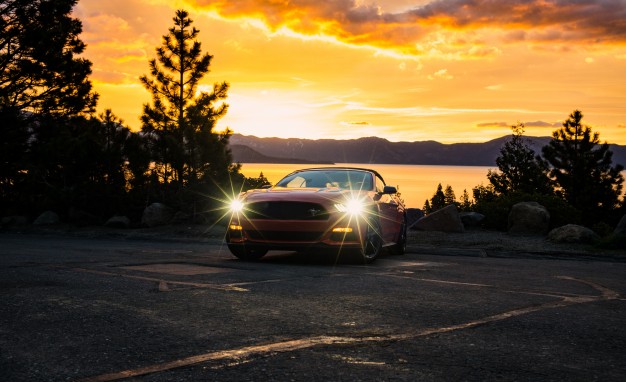
To get a sense of how the modern California Special sits in its namesake state, I decided to drive east to west—from border to coast—starting at the Nevada/California state line in Crystal Bay, at the north end of Lake Tahoe. With the ascendancy of Silicon Valley, Tahoe has become a thing again, as it’s an easy three-hour drive from San Francisco and offers a host of outdoor activities for the Fitbit-obsessed. Across the street from my starting point sits the Cal Neva Resort & Casino, once owned by Frank Sinatra, Dean Martin, and mobster Sam Giancana, which should re-open this year after extensive renovation, ready to welcome a new generation of lakeside swells.
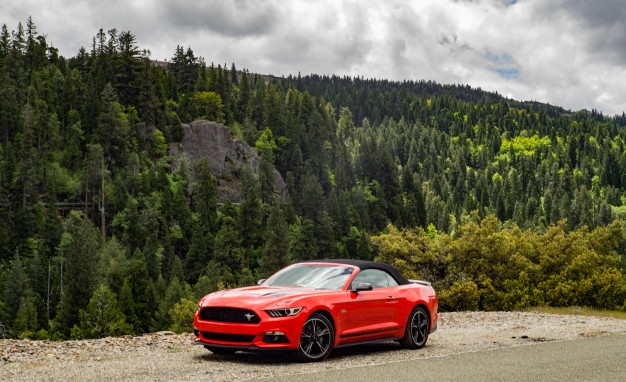
After running up State Route 89 to Truckee and following I-80 over Donner Summit, I eschewed the Interstate in favor of State Route 20, which would take me all the way to the Pacific coast at Fort Bragg. Tahoe is most certainly a somewhere, and I was more interested in nowhere. Route 20 offers a more meditative, less pell-mell descent from the High Sierra, meandering down into the twin foothill towns of Grass Valley and Nevada City, then on past the northern edge of Beale Air Force Base, where they still use muscle cars to help U-2s land. When the hills end, the highway jinks through the conjoined towns of Marysville and Yuba City, which, in 1985, were somewhat-famously rated as the worst place to live in America.
From there on, it’s mile upon mile of rice paddies, with only the Sutter Buttes rising up to the north to break up the numbingly level floor of the Sacramento Valley. A ring of eroded, uneven crags stands as evidence that a long-dormant volcano once erupted here. Valley residents proudly proclaim it “the world’s smallest mountain range.” The smallest range, the worst place to live. The Central Valley, from Redding on down to Bakersfield, alternately boasts of its import (Oil! Almonds! Merle Haggard! An NBA team!) and cringes at its internalized inferiority to the beauty, bustle, and wealth of the coast.
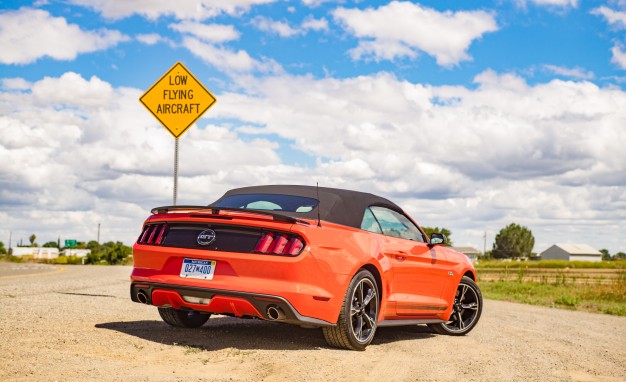
Cross I-5 at Williams and the visuals start to pick up as the Coast Range looms. Route 20 climbs into the hills and skirts the edge of Clear Lake. As naturally occurring lakes go, it’s California’s third largest after the Salton Sea and Tahoe, though glamorous Tahoe lies partially in Nevada, and the benighted Salton Sea was refilled entirely by accident. While Tahoe is ringed by money, and the Salton Sea by the decaying husks of once-thriving resorts, Clear Lake continues on as it has, a Middle-American sort of place, lovely and a bit rough around the edges. It’s not unlike Michigan’s Irish Hills, if the Irish Hills were taller and abutted a large body of water.
Route 20’s final stretch runs from Willits to the coast. My fondest memory of the place was a warm summer night spent at a KOA there sometime in the mid-1980s. My dad and I lay on the hood of our Mercury Colony Park, looking up at the abundant starscape, watching the Perseids streak through the sky. It was the first meteor shower I’d ever seen. In 2016, Willits was just a momentary stop, an exchange with friendly — if tweaky — gas-station attendants, a quick Red Bull and a cigarette, and then on toward Fort Bragg. If one does not become entangled in traffic, 20 from Willits to the coast is a driver’s delight, and for a few miles, I opened the California Special’s taps, barked blipped downshifts into the trees, and played a bit of tag with a blacked-out Model S P85D. Then we got stuck behind a lumbering Safeway truck.
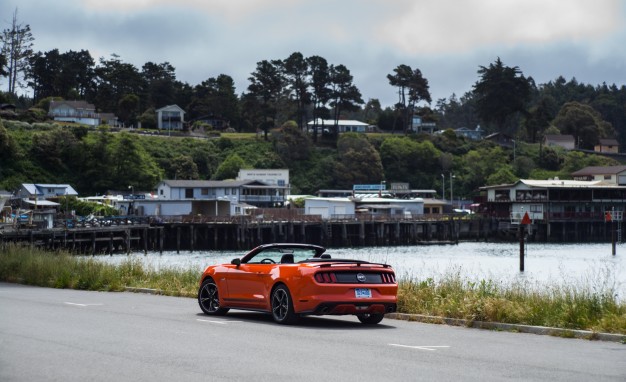
Fort Bragg was nothing but lumber and fishing when I was a kid, a Georgia-Pacific town with a picturesque harbor at the mouth of the Noyo River. Since the mill shut down and the Chinook salmon fishery dwindled, industry has been somewhat replaced by tourist-facing business, but the real economic engine of Mendocino County is marijuana. As Julia Carrera of the Small Farmers Association told the LA Times, “It would be like Appalachia without marijuana. Economically, it would be dead.” With the wine industry having oozed north from Sonoma County into southern Mendocino, and craft brewers like Anderson Valley Brewing and the Mendocino Brewing Company having become staples of the beer scene, building materials and fish have been replaced by intoxicants as Mendo’s growth industry.
Economics aside, the area’s impossibly beautiful. As I meandered down Highway 1 from Fort Bragg to San Francisco to catch a Bob Mould show at the Independent, the sun split the clouds somewhere around Salt Point. I had the Mustang’s top down, and reveled in long, satisfying torquey pulls between throws of the shifter. The Grabber Orange hood chased a gray ribbon through green pastures, dipped down into dark stands of trees, then popped up and out, the azure Pacific just off the passenger door. The impossibility of the vista at once opens your heart and puts you firmly in cosmic check. Around Gualala, Sotheby’s real estate signs appear at the edge of the highway, signaling that you’ve entered Properly Expensive Country.
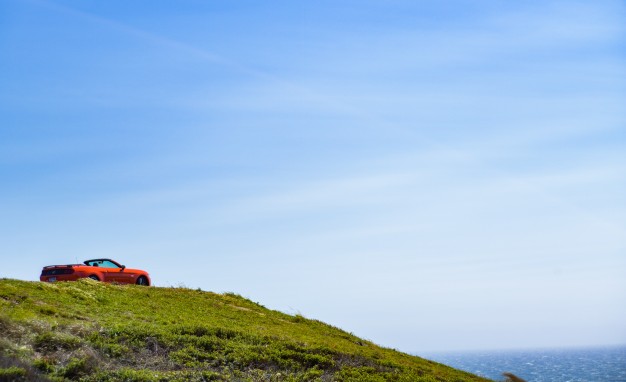
In San Francisco, the city most dramatically emblematic of the Golden State’s recent shifts, the former Hüsker Dü frontman was in a jovial mood. It was the last night of the tour, and he’d sleep in his own bed tonight. Mould bummed a spliff from a guy in the front row, shared a couple of hits with drummer Jon Wurster, and then launched into a Van Halen-esque impromptu version of “You Really Got Me.” In the 1980s, the Hüskers were practically Van Halen’s inverse: a trio of shabby Midwesterners barnstorming the country in a van while Eddie Van Halen blasted around LA in a Miura and David Lee Roth ate ’em and smiled.
The cover was a piss-take of the larger-than-everything SoCal hair scene of the 1980s, but it wasn’t exactly mean-spirited. We’re all getting old; at what point does keeping the us-vs.-them facade fully erect just become silly? Wurster kicked off a blistering version of Hüsker Dü’s 1985 album-opener “New Day Rising” to close the show. Nobody in the room was relevant to the youth market anymore—not even ex-Dead Kennedy and former SF mayoral candidate Jello Biafra—but damn if the band didn’t do its best to take us back there. I grabbed my bag from coat check and walked out to the Mustang, wondering how much longer the 55-year-old Mould could pull off sets that intense, and furthermore, how much longer his graying audience will keep coming out to see him wail. Beyond that, for how long can naturally aspirated V-8s remain a viable thing? Does Bullitt even register with those willing to stand in an overnight line at a Tesla store?
For a time, a dedicated coterie will keep the cars running, even as they’re drummed out of automaker lineups by turbocharging and electrification. Eventually, they’ll drift from the consciousness of the young, much as we look at steam-powered vehicles today. Within two generations, today’s Mustang GT will undoubtedly seem as archaic to a 40-year-old as a flathead-powered Deuce does to my cohort. The GT/CS is an anachronism and an optimistic fiction balled into a tidy, usable package skinned with the trappings of modernity. This particular example, with its convertible top and optional 3.31 limited-slip rear axle, sells for $47,380. You undoubtedly could pick up a disused salmon boat or a manufactured home in Yuba City for less, but a glorified shack on the Sonoma/Mendocino coast or a place up in Tahoe will run you quite a bit more. Ultimately it all depends on which piece of California—which myth, which reality—you care to buy into. The only guarantee I can make is that 50 years from now, there will be a new most interesting thing in the country, and there’s a damn solid chance that California will be at the heart of it.

Powered by WPeMatico



